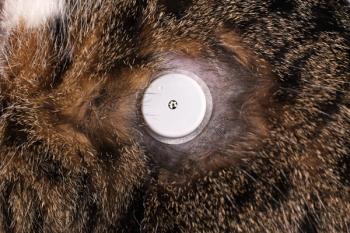
EPA probes suspected link between household chemical, feline hyperthyroidism
National Report - A potential connection between feline hyperthyroidism (FH) and a flame-retardant chemical found in common household products, house dust and some food items may exist, concludes a recent Environmental Protection Agency (EPA) study.
NATIONAL REPORT — A potential connection between feline hyperthyroidism (FH) and a flame-retardant chemical found in common household products, house dust and some food items may exist, concludes a recent Environmental Protection Agency (EPA) study.
Polybrominated diphenyl ethers (PBDE) were introduced into household materials nearly 30 years ago, coinciding with the dramatic increase of FH cases.
"We hypothesized that increases in FH were, in part, related to increased PBDE exposure, with key routes of exposure being diet and ingestion of house dust," says Dr. Janice A. Dye, veterinary internist at the EPA's National Health and Environmental Effects Research Laboratory and one of four study co-authors.
"I was hoping we would find levels, but I was surprised at how high they were. And we don't know how high is bad. Cats are definitely being exposed. Our hypothesis is right there," Dye says.
Their research confirmed high levels of PBDEs in cats — 20 to 100 times greater than the median levels in American adults — but did not offer conclusive evidence linking this exposure to FH.
"We did confirm that cats are consistently exposed and their levels are quite a bit higher than the average person, but we have in no way proved that this is causing their hyperthyroidism," Dye says. "That is where the next studies are going to play out. We are in the reassessment stage."
Although PBDEs are on their way out of common household products after being banned and discontinued in many areas, it is important to continue research, Dye says. If a link is discovered between PBDEs and FH, identifying the specific compounds causing endocrine disorders is vital to ensure a replacement flame retardant does not have the same health consequences.
Understanding the impact to cats also may help to better protect humans, Dye says. Although very few studies analyze PBDE levels in children, researchers have speculated that cats and children may have similarities in their exposure levels because of shared habits. Dye explains that pets are exposed to house dust by sleeping or lying on the floor — which children often do — and by constantly grooming themselves throughout the day, similar to children who pick items off the floor and put them in their mouths.
"Cats may be a good sentinel for humans. Their life spans are shorter, but they have excellent dietary and exposure histories. They can be a good canary in the coal mine for other interrelated diseases," Dye says. "Cats who share our home environments and share some of the same food sources may help us get a better handle on whether these low-level exposures are linked to a disease entity. We are asking some questions and alerting to the possibilities."
Newsletter
From exam room tips to practice management insights, get trusted veterinary news delivered straight to your inbox—subscribe to dvm360.




